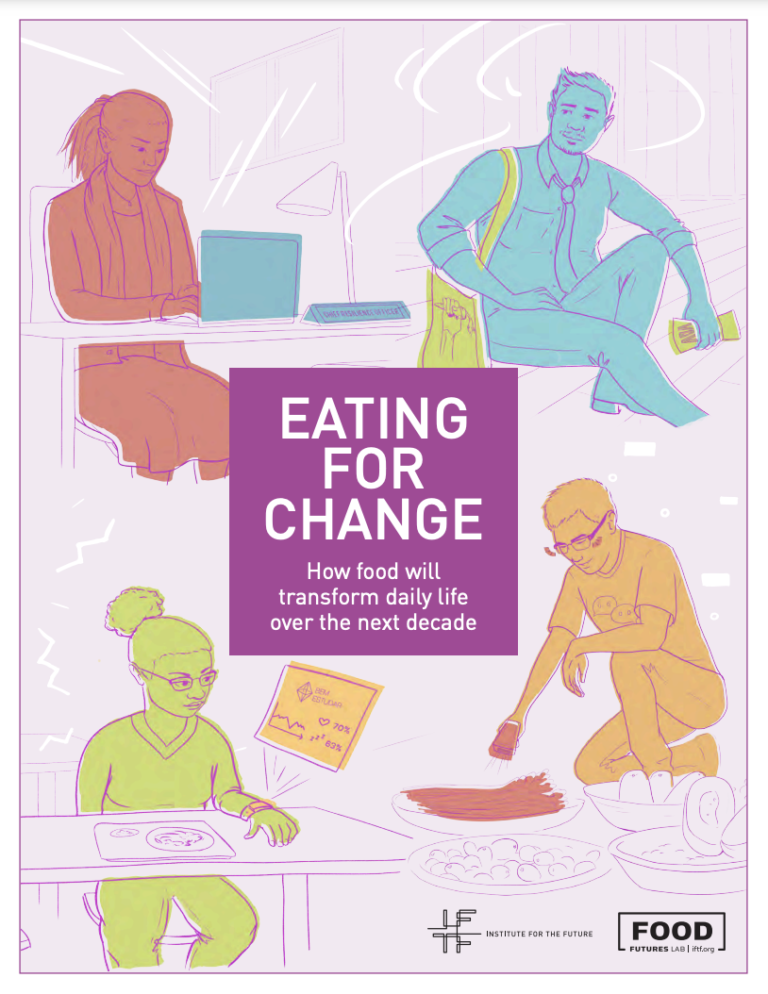Eating for Change is an in-depth look at the future of a food movement that has been in the making for decades. Like all movements, it started with a small group of passionate people who challenged the status quo—in this case, across agriculture, health care, and gastronomy. At school gardens and urban community farms, these disruptors leveraged financial, social, political, and natural resources to create new models for local food systems. Along the way, technological innovators and social entrepreneurs joined the cause, and these local efforts started to scale up as people shared practices across global food innovation networks. Today these engaged eaters are transforming the marketplace, impacting even the most established global brands and food industry stakeholders. Over the next decade, their influence will expand beyond food systems to address concerns regarding health, trust, justice, and environmental stewardship. Food will be a medium for transforming all aspects of daily life. We call this eating for change.
Grounded in ethnographic research into today’s eaters for change in cities from Shanghai to San Francisco, this report covers four aspirations for Eating for Change, each with two forecasts about specific ways people will use food as a medium for transformation in the next decade:
- Nourishing Bodies and Minds: From food as a risk factor to food as a catalyst for well-being
- High-Resolution Health: Toward new information authorities and emerging food anxieties
- Digital Food Therapists: Toward AI-powered, personalized food coaching
- Rebuilding Trust: From eroded brand credibility to transparent, digital food stories
- Tamper-Proof Transparency: Toward technologies that let food speak for itself
- Computational Food Propaganda: Toward food media that breaks—or reinforces—filter bubbles
- Seeking Justice: From food as a commodity to food as a human right
- Equitable Foodscapes: Toward food and social systems that prioritize good food access
- Restorative Food Economies: Toward business models that put food to work for social justice
- Aligning with the Environment: From climate-disruptive to regenerative agriculture and eating
- Edible Environmentalism: Toward ingredients that perform an ecosystem service
- Climate Change Cuisine: Toward recipes that evolve for human and planetary resilience
Read the full report to learn about the signals of change—technologies, practices, partnerships, and approaches in the present that point to new directions for the future. Each chapter also contains insights about what these new behaviors, technologies, and aspirations mean for stakeholders across the food system.
Four future personas bring to life the stories our ethnography uncovered from around the world, with a focus on the tools and environments that will shape possibilities for eating for change in the future.

- Sophia Silva tells the story of a high-school student in Brazil defining a healthy food practice
- Like most teenagers, Sophia is trying to establish her own habits and sense of identity, especially with food. But this coming-of-age process is complicated by the foodscape she lives in and what she knows about her health. A new program at school may help her define her own healthy food practice.
- Like most teenagers, Sophia is trying to establish her own habits and sense of identity, especially with food. But this coming-of-age process is complicated by the foodscape she lives in and what she knows about her health. A new program at school may help her define her own healthy food practice.
 Jin Liu shows how a mid-20’s man in China is building trusted food networks
Jin Liu shows how a mid-20’s man in China is building trusted food networks- Jin Liu spends his days working on-demand across many platforms. He might be a food delivery app driver, an on-demand urban farmer, a dinner host on the mealsharing app YiqiChifan, and a freelance marketing consultant all in the same day. Let’s catch up with him as he gets ready to host his YiqiChifan guests.
- Jin Liu spends his days working on-demand across many platforms. He might be a food delivery app driver, an on-demand urban farmer, a dinner host on the mealsharing app YiqiChifan, and a freelance marketing consultant all in the same day. Let’s catch up with him as he gets ready to host his YiqiChifan guests.
 Daniel Martinez follows an activist in California advocating against food disabilities
Daniel Martinez follows an activist in California advocating against food disabilities- Daniel Martinez is a community organizer in the East Bay communities of the San Francisco Bay Area. He spends his days fighting for the rights of people with food disabilities—arguing that so-called lifestyle diseases are actually disabilities that result from inequitable access to food. Here’s what he’s up to one afternoon in Oakland.
- Daniel Martinez is a community organizer in the East Bay communities of the San Francisco Bay Area. He spends his days fighting for the rights of people with food disabilities—arguing that so-called lifestyle diseases are actually disabilities that result from inequitable access to food. Here’s what he’s up to one afternoon in Oakland.
 Anna Nielson imagines the new role for the public sector in developing regenerative food economies
Anna Nielson imagines the new role for the public sector in developing regenerative food economies- Anna Nielson is Copenhagen’s Chief Food Resilience Officer. In this newly created position in the city’s Department of Technical and Environmental Administration, Anna is working to jump-start a resilient food economy. Check out the initiatives that are keeping her busy right now.
- Anna Nielson is Copenhagen’s Chief Food Resilience Officer. In this newly created position in the city’s Department of Technical and Environmental Administration, Anna is working to jump-start a resilient food economy. Check out the initiatives that are keeping her busy right now.

